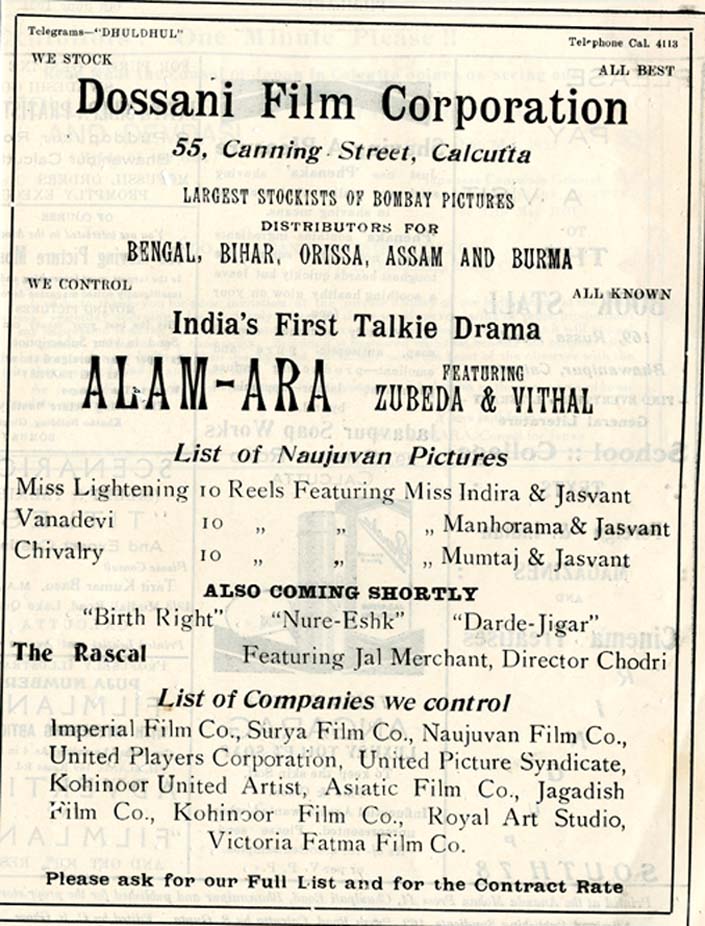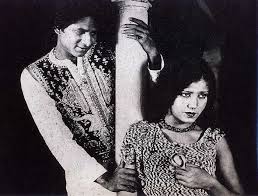Indian cinema: 1920-29
| Line 1: | Line 1: | ||
== Indian cinema: 1920-29 == | == Indian cinema: 1920-29 == | ||
| − | |||
| − | |||
| − | |||
| − | |||
| − | |||
| − | |||
{| class="wikitable" | {| class="wikitable" | ||
| Line 34: | Line 28: | ||
See [[examples]] and a tutorial.</div> | See [[examples]] and a tutorial.</div> | ||
|} | |} | ||
| + | [[File:aa.jpg|Alam Ara|frame|500px]] | ||
| + | |||
| + | [[File:aa2.jpg|frame|500px]] | ||
| + | |||
| + | [[File:aa3.jpg|Alam Ara|frame|500px]] | ||
===1920=== | ===1920=== | ||
By the 1920s, film companies in Bombay and Calcutta were making films with generous doses of sex and skin-show, and it was alleged that students and younger people were drawn into promiscuity by the moving pictures. Such was cinema's sway that in 1927 the government set up the Indian Cinematograph Enquiry Committee to investigate the adequacy of censorship and the supposedly immoral effect of cinematograph films. The 1920s' silent stars like Sulochana and Ermeline were overtly sexualized; the screen kiss was common in silent films before it became taboo after the coming of the talkies. | By the 1920s, film companies in Bombay and Calcutta were making films with generous doses of sex and skin-show, and it was alleged that students and younger people were drawn into promiscuity by the moving pictures. Such was cinema's sway that in 1927 the government set up the Indian Cinematograph Enquiry Committee to investigate the adequacy of censorship and the supposedly immoral effect of cinematograph films. The 1920s' silent stars like Sulochana and Ermeline were overtly sexualized; the screen kiss was common in silent films before it became taboo after the coming of the talkies. | ||
Revision as of 16:53, 28 April 2013
Indian cinema: 1920-29
Title and authorship of the original article(s)
|
Brief history of Indian cinema By UrooJ, aligarians.com, mid-2000 |
Bollywood Cinema By h2g2, mid-2000 |
This is an article selected for the excellence of its content. |
1920
By the 1920s, film companies in Bombay and Calcutta were making films with generous doses of sex and skin-show, and it was alleged that students and younger people were drawn into promiscuity by the moving pictures. Such was cinema's sway that in 1927 the government set up the Indian Cinematograph Enquiry Committee to investigate the adequacy of censorship and the supposedly immoral effect of cinematograph films. The 1920s' silent stars like Sulochana and Ermeline were overtly sexualized; the screen kiss was common in silent films before it became taboo after the coming of the talkies.
1920 : Film Censor Boards set up in Bombay, Madras, Calcutta and Rangoon. Ardheshir Irani starts his first studio, Star Film Company. Nala Damayanti is first International Co-production. Suchet Singh, who had trained in Hollywood releases Shakuntala starring Dorothy Kingdom. The Bengali Film Weekly Bijoli starts.
1921 : Kohinoor’s Bhakta Vidur (1921) runs foul of the censors as its protagonist bears more than an uncanny resemblance to Mahatma Gandhi. Dhiren Ganguly makes the Anti-West satire England Returned. R.S. Prakash starts the Star of the East Film Company. In Calcutta, Anandi Bose starts Aurora Film Corporation, a distribution company.
1922 : Entertainment Tax on Film exhibition is levied in Calcutta. Rewashankar Pancholi starts Empire Film Distributors in Karachi and Lahore, importing American films.
1923 : Entertainment tax of 12-½ % is levied in Bombay. The Saurashtra Kinemograph is set up in Rajkot. The elite literary journal Bharati (founded in 1877) carries a serialized history of Bengali cinema.
1924 : Dhiren Ganguli is expelled by the Nizam from Hyderabad for exhibiting Razia Begum. India’s first periodical exclusively devoted to cinema Mouj Majah (Gujarati) is launched in Bombay by J.K. Dwivedi. Nanubhai Desai and others start Saraswati Film. Maneklal Patel starts Krishna Film. Kamala Movietone started in Lahore.
1925 : The first major film adaptation of the social reform novel - Baburao Painter’s Savkari Pash. Fatima Begum, probably the first Indian woman producer, starts her production company and debuts with Bulbul-e-Parastan. Sharda Film is started and formalizes the stunt film genre. The Indo-German co-production The Light of Asia is released abroad to great critical acclaim. The Madurai Bala Shanmughananda Sabha is started dominating pre-independence Tamil Theatre and film.
1926 : Foundation of the Punjab Film Corporation in Lahore, inaugurating the Punjabi Film Industry. Ardheshir Irani starts Imperial Films in partnership with Abdulallay Esoofally. Vande Mataram Ashram is censored and briefly banned. The journal Photoplay starts in Calcutta.
1927 : Indian Kinema Arts Studio starts in Calcutta. On October 6, Government of India announces appointment of a Committee of Enquiry, The Indian Cinematograph Committee. Film journals Movie Mirror (Madras) and Kinema (Bombay) are started.
1927-28-The Indian Cinematograph Committee publishes its report. The British administration ignores the report. A.R. Kardar starts the United Players Corporation in Lahore. First Malayalam feature - J.C. Daniel’s Vigathakumaram. R. Padmanabhan founds the associated Film Studio in Madras.
1929 : Wall Street crashes ending negotiations about a major Hollywood expansion into India. Several important studios are started among them Prabhat film Company in Kolhapur, Ranjit Movietone in Bombay, British Dominion Films Studio and Aurora Film corporation in Calcutta and General Pictures Corporation in Madras. The Gujarati film periodical Chitrapat and the Moving Picture Monthly are launched in Bombay. Universal’s Melody of Love is the first sound feature released in India at the Elphinstone Picture Palace. Bengali monthly Deepali launched.
Indian cinema: historical outline Covers the era before the first Indian feature film
Indian cinema: 1920-29
Indian cinema: 2010-19

